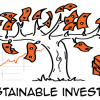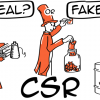Transcript
Carbon footprint: definition, calculation, reduction
Hi folks, Alex here. This is pure carbon. So, technically, this is a carbon footprint, right? Sort of… In this video, we are going to explain what we really mean by carbon footprint, how it is calculated, why we need to reduce it and how to reduce it with lots of examples. Ok, let’s get drawing!
Part 1: What is a carbon footprint?
In a previous video I explained what is our ecological footprint. In a nutshell, it is how much land and water area we need to produce the resources we use and to absorb our waste. Here is a link to that video if you haven’t seen it. One resource that we use a lot of is carbon, mostly from the burning of fossil fuels. [Now, this is a cute drawing but truly THIS is what fossil fuels extraction looks like nowadays] When we do that, it produces greenhouse gases such as carbon dioxide. There are other greenhouse gases but to keep it simple and easy to compare, we count it as CO2 equivalent. So part of our ecological footprint is actually our carbon footprint: it is amount of CO2 equivalent that is released into the atmosphere as a result of our activities. In my case, about half my ecological footprint is carbon and worldwide it is about 60%. We can also calculate the carbon footprint of the world, a country, a business, an individual, an event, a product, etc. For example, when we travel with a vehicle that burns fossil fuels, it clearly releases carbon into the atmosphere. If I use an electric vehicle, then the question is: how is the electricity produced? In the United States and China for instance, the two countries with the largest carbon footprint, about 65% of the electricity is produced from fossil fuels so there is a good chance that an electric car generates a lot of CO2. But I am already getting into how the carbon footprint is calculated so how do we do that?
Part 2: How is the carbon footprint calculated?
Well, you are going to need a pen, a notebook, a calculator, no I am kidding, calculating your carbon footprint is like many other things nowadays, there is a website for it. If you are in the US I recommend this one. If you are in the UK, I recommend this one. If you are anywhere else, I recommend this one. Essentially, you enter how much energy it takes to heat your home, how much driving and flying you do, how much money you spend on food, clothes, technology, investment, etc. and the engine behind it translates everything into how many metric tons of CO2 equivalent that is. Adding it all up at the end, you get your carbon footprint. Mine is 8.63. It is significantly lower than the average in Canada where I live but you can see that it is significantly higher than the world’s average and, more importantly, to the worldwide target.
Part 3: Why do we need to reduce our carbon footprint?
Where does this target come from? The scientific community agrees that when we use fossil fuel, it releases greenhouse gases into the atmosphere, which makes its temperature rise. We have emitted so much of these greenhouse gases over the past century that the earth is getting warmer than it has been over the past 400,000 years (we found that out by drilling ice cores in Antartica which is the topic of another video you can watch if you like). So we need to reduce our emissions which means we need to reduce our carbon footprint.
Part 4: How to reduce our carbon footprint?
How do we do that? One option is carbon offsets. This means paying a certain amount of money, depending on your emissions, that will go toward a program designed to reduce the same amount of carbon emissions somewhere in the world: either by planting trees, building a wind farm, a solar power plant, etc. When you calculate your carbon footprint, some calculators will give you a link to offset your carbon emissions. If I chose this one for instance, it would cost me less than 100$ (Canadian) to offset my carbon emissions for the entire year. Great deal, right! But here is the rub: Planting trees does not make airplanes fly. YET! So offsetting does not keep the fossil fuels (the carbon) in the ground. It just transfers the problem onto another project somewhere else in the world while we keep extracting them. In a way, it is like killing panda bears and donating to WWF to protect them. Carbon offsets should be seen as a great way to fund tree planting and renewable energy projects around the world in order to transition away from fossil fuels. NOT as a long term solution. The best way to reduce my carbon footprint is to address its root causes so the carbon is not extracted in the first place. I can live in a smaller home, improve its insulation, heat it with geothermal energy for instance, use less electricity, have more of my electricity produced from renewable energy, walk and bike to drive less with in car, when I do drive, use a very efficient vehicle, maybe an electric vehicle given that the electricity is mostly hydro where I live, fly less, eat less meat, especially beef which generates a lot of carbon emissions. And finally, one we don’t talk about very often: be smart with my investments, meaning the money I give to financial institutions through my mortgage and insurance products. Why? Because most banking and finance organizations invest my money into… fossil fuels. According to carbonfootprint.com, if I cut my mortgage, it would reduce my total annual carbon footprint by 2 metric tons, 20% of my total carbon footprint! Finally, according to the 2020 gap report published by UNEP, the 10% part of the population that earns the most money have just about the same collective carbon footprint as the other 90% so it is our entire system that is dysfunctional and at the end of the day, the best way to reduce our carbon footprint is to take action and to vote for those who will help create the new systems that we need.






